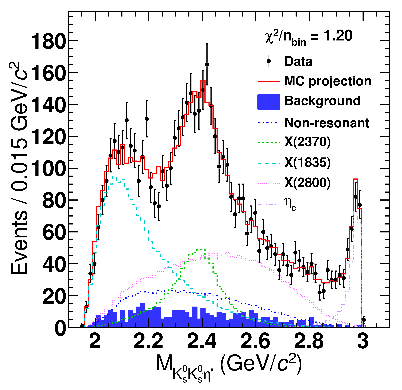The Beijing Electron Positron Collider II (BEPCII) has recently made a significant achievement. The BESIII experiment at BEPCII performed the first measurements of the quantum numbers of the X(2370) particle, along with its mass, production, and decay properties, and found that they are consistent with the features of a glueball, which has long been the subject of intensive experimental searches. This important result was published in the journal of Physical Review Letters on May 2nd as an Editor’s Suggestion.
In the Standard Model (SM) of particle physics, the strong nuclear force is described by Quantum Chromodynamics (QCD). Gluons are the fundamental particles mediating the strong interactions, just as photons mediate electromagnetic interactions. Within this framework, gluons can attract each other to form new bound states called glueballs. The existence of glueballs is an important prediction of QCD, and they are the only particles in nature composed of force mediators only. The existence of these bound states is a crucial and fundamental test of the SM, but no candidates have yet been unambiguously identified. Decays of the J/ψ particle produce a gluon-rich environment and are an ideal place to search for glueballs. The very large and clean samples of J/ψ decays collected by the BESIII experiment are therefore extremely interesting.
The X(2370) particle was first discovered at the BESIII experiment in 2011. It was the first observation of a particle whose mass and production and decay properties are consistent with the pseudoscalar glueball (a glueball with quantum numbers of zero spin and negative parity) predicted by Lattice Quantum Chromodynamics theory. To confirm the pseudoscalar glueball state experimentally, the most crucial step is to determine whether the spin parity quantum numbers of the X(2370) are indeed zero spin and negative parity.
In recent years, the BESIII detector at BEPCII successfully collected about 10 billion J/ψ decays, more than 100 times larger than previous experiments. With these large samples, researchers performed a detailed study of X(2370) decay modes in an environment almost entirely free of background contamination. With the excellent design of the BESIII detector, providing high-precision detection of charged particles and photons, the signal-to-noise ratio has been greatly improved. With a complex partial wave analysis, the collaboration performed the first measurement of the spin-parity quantum numbers of the X(2370), as well as its mass and yield. The experimental results are consistent with the features of the lightest pseudoscalar glueball predicted by the Lattice Chromodynamics, which provides strong experimental evidence supporting the existence of glueballs.
Fig.1. Schematic diagram of the J/ψ radiative decay to the X(2370) particle. (Credit: IHEP)
Fig.2. Invariant mass spectrum of KS0KS0η' in J/ψ→γKS0KS0η'. (Credit: IHEP)
Paper link :
https://link.aps.org/doi/10.1103/PhysRevLett.132.181901The link to the popular science article on the Big Think website in US:
https://bigthink.com/starts-with-a-bang/new-particle-first-glueball/The link from German media:
https://www.spektrum.de/news/teilchenphysik-teilchenbeschleuniger-findet-hinweise-auf-gluonenball/2216326Link to the pseudoscalar glueball in LQCD:
https://journals.aps.org/prd/abstract/10.1103/PhysRevD.100.054511Keywords: BESIII, glueball-like particle , X(2370) , spin-parity quantum numbers



